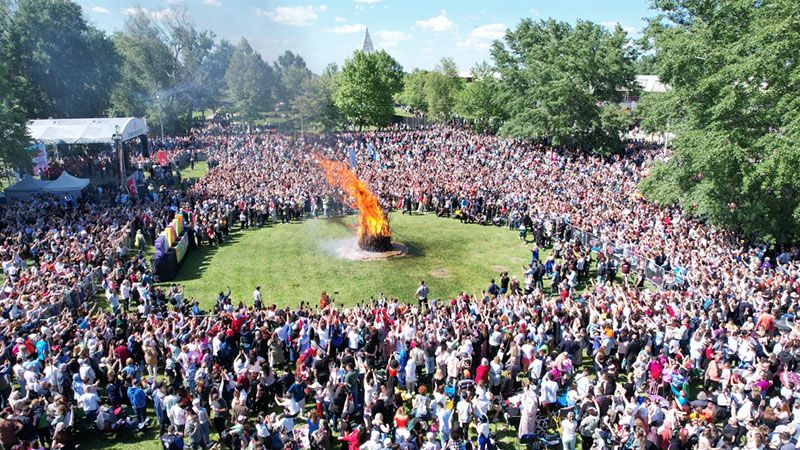
Hıdırellez: A Celebration of Spring, Hope, and Wishes
Hıdırellez: A Celebration of Spring, Hope, and Wishes
Every year on the night between May 5 and May 6, people across Turkey and parts of the Balkans celebrate Hıdırellez, one of the most vibrant and ancient spring festivals. With roots stretching from Central Asia to Anatolia and the Middle East, Hıdırellez symbolizes the awakening of nature, abundance, hope, and new beginnings.
But what exactly is Hıdırellez? Where does it come from, and how is it celebrated? Let’s take a closer look at this colorful and meaningful tradition.
The Origins and Meaning of Hıdırellez
The word "Hıdırellez" comes from the names of two legendary figures: Hızır and İlyas. In Turkish folklore, Hızır is believed to be an immortal being who helps those in need, brings blessings and abundance. İlyas is seen as the protector of seas. According to legend, these two spiritual figures meet once a year — on the night of Hıdırellez. Their reunion is believed to bring vitality to the earth and mark the arrival of spring.
In essence, Hıdırellez reflects the deep connection between people and nature. The earth awakens from its winter sleep, flowers bloom, animals give birth, and people look toward the future with renewed hope.
When Is Hıdırellez Celebrated?
Hıdırellez is celebrated every year on May 6 according to the Gregorian calendar. In the old Rumi (Julian-based) calendar, this date corresponds to April 23, known as "Ruz-ı Hızır" (The Day of Hızır). In traditional Anatolian culture, the time between May 6 and November 8 is called the "Days of Hızır", marking the summer period. The rest of the year is referred to as the "Days of Kasım", representing winter.
How Is Hıdırellez Celebrated?
Hıdırellez is celebrated with joy, music, and various rituals that vary from region to region, though many traditions are widely shared. Here are some of the most common:
1. Wishing Rituals
One of the most beloved aspects of Hıdırellez is making wishes. People express their desires in different ways:
Writing them on paper and placing them under a rose bush.
Drawing symbols (like a house, car, or heart) on the soil to represent their wishes.
In some regions, people release their wishes into water.
The rose bush is believed to be a sacred place where Hızır might pass by and grant the wishes.
2. Jumping Over the Hıdırellez Fire
Bonfires are lit on the night of Hıdırellez, and people jump over the flames three times. This ritual is believed to cleanse the soul and body, ward off evil, and bring good health for the year ahead.
3. Picnics and Outdoor Celebrations
On May 6, many families and communities gather outdoors in nature — parks, gardens, or countryside — to celebrate. There are traditional games, folk music, dancing, and shared meals. It’s a celebration of nature’s rebirth and human connection.
4. Fortune Telling with Wish Jars
In some areas, young girls place personal items like rings or bracelets into a jar the night before. The jar is then placed under a rose bush. The next morning, a fortune-telling ritual takes place where each item is drawn out while reciting traditional rhymes or poems, trying to foresee each girl’s future.
The Spiritual Side of Hıdırellez
Hıdırellez is more than just a festival — it's a moment for reflection, gratitude, prayer, and hope. It’s a time to let go of the old and welcome the new. Many believe that wherever Hızır visits, abundance, peace, and healing follow.
Even in today’s fast-paced, modern world, Hıdırellez remains an important reminder of our connection with nature, tradition, and community.
Hıdırellez Recognized by UNESCO
In 2017, Hıdırellez was officially added to the UNESCO Representative List of the Intangible Cultural Heritage of Humanity, through a joint submission by Turkey and North Macedonia. This international recognition highlights the cultural richness and significance of Hıdırellez beyond national borders.
COMMENTS

Mehmet
Educall'un Hıdırellez’i bu kadar güzel ve akıcı bir şekilde anlatması gerçekten harika olmuş! Hem kültürel detaylara hem de geleneklerin ruhuna değinmeniz çok etkileyiciydi. Özellikle yazının İngilizce olması sayesinde, bu önemli Türk geleneğinin uluslararası alanda tanıtılmasına büyük katkı sağlıyorsunuz. Kaleminize sağlık, böyle içeriklerin devamını dört gözle bekliyorum!
Enes
Educall’un Hıdırellez’e dair yayımladığı bu blog yazısı, geleneksel Türk kültürünün önemli ritüellerinden birini hem tarihsel kökenleri hem de günümüzdeki yansımalarıyla ele alması bakımından son derece kıymetli bir çalışma olmuş. Yazıda, halk inanışlarıyla mevsimsel döngüler arasındaki ilişki net bir şekilde ortaya konmuş; ayrıca Hıdırellez’in Anadolu’nun kültürel çeşitliliği içerisindeki konumu başarılı bir şekilde analiz edilmiş. Konuyu sade ama akademik bir üslupla, aynı zamanda ingilizce ele almanız, hem uluslarası okuyucuya hem de alanla ilgilenen araştırmacılara hitap ediyor. Bu tür içeriklerin çoğalmasının kültürel ve ulusal bilinç açısından çok önemli olduğunu düşünüyorum. Emeğinize sağlık.